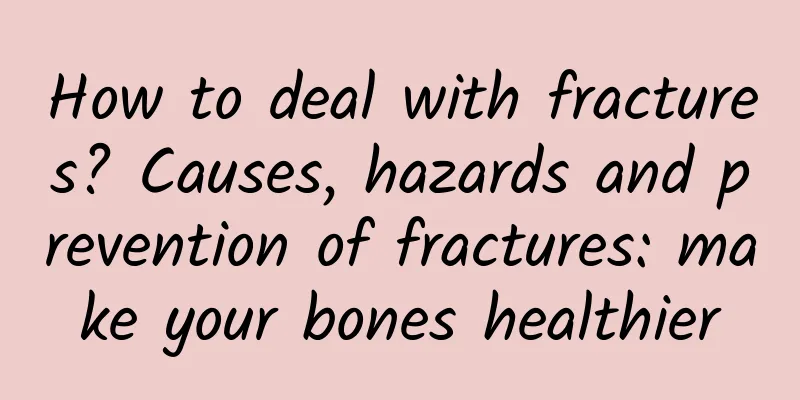Don’t take heel pain lightly, it may be caused by these 3 diseases!

|
This article was reviewed by Ao Rongguang, MD, Master's tutor, deputy chief physician of orthopedics at Shanghai Pudong Hospital, and head of the key subspecialty of osteoporotic fractures in Pudong New Area In daily life, it is normal to have foot pain if you don’t wear the right shoes, walk too much or stand for a long time. In this case, rub and relax your feet, and the pain will be relieved the next day. However, if the heel pain persists for a long time and recurs repeatedly, it may be caused by a disease! Copyright image, no permission to reprint There are three common causes of heel pain. You can check them yourself first: 1 First step pain when getting up early It could be plantar fasciitis ● The foot fascia is an elastic tissue that supports the foot muscles and is composed of water, collagen fibers, elastin, hyaluronic acid, etc. The reason why the fascia becomes inflamed is mainly because it is repeatedly stretched, the structure is injured, and aseptic inflammation occurs. Risk factors for plantar fasciitis ① Obesity; ②Excessive exercise, especially running and other sports; ③ Wearing shoes that do not fit well or have poor cushioning for a long time. For example, some people like to wear hard-soled cloth shoes and high heels; ④ Walking or standing on hard surfaces for a long time; ⑤ Occupational factors: such as ballet dancers, teachers, athletes, etc. Pain characteristics of plantar fasciitis ① The pain in the soles of your feet is most obvious when you get up in the morning and your feet just touch the ground, but after walking ten steps, the pain will gradually ease. This is the most obvious feature; sometimes after sitting for a long time, you will feel dull pain in the first few steps when you stand up and walk; ②The pain mainly occurs on the inner side of the heel, and may also occur in the center of the foot; the pain is pulsating and burning; ③Some patients will experience increased pain at night. If this happens, it is best to go to the hospital for X-rays and other examinations in time. Exercise the soles of your feet to avoid plantar fasciitis Action 1: Place a tennis ball or foam roller on the ground, step on it, and slowly roll back and forth for 3 to 5 minutes. Repeat 2 to 3 times. This will help relax the plantar fascia and muscles. Action 2: Sit on a yoga mat, grab your toes with your hands and pull them back until you feel a stretch on the sole of your foot, hold for 15 to 30 seconds, then relax, and repeat 5 times. This action also helps relax the plantar fascia. Action 3: Place a towel on the yoga mat, place the heel of the affected foot on the towel, and use your toes to repeatedly grab and release the towel. Repeat 10 to 20 times. This will help strengthen the plantar flexor muscles. 2 Pin-like pain, limited movement It may be heel bone hyperplasia ● The heel is a support point of our body, and it is under great pressure for a long time. At the same time, the plantar fascia and the soft tissue attached to the heel are constantly stretched and stimulated. As we age, local ossification will gradually form, and eventually bone hyperplasia may occur. Once bone hyperplasia is formed, it is difficult to disappear on its own. Over time, when it stimulates the surrounding nerves or soft tissues, it will cause pain. Characteristics of calcaneal bone hyperplasia Heel bone hyperplasia generally has three characteristics, which can be identified by yourself: ① When you press your heel down hard, you will feel pain. The pain is fixed and sharp, like a needle prick. Massage with your hands for a while, the pain will be relieved and a slight numbness will appear. ② In severe cases, pain may also occur in the center of the foot. The pain lasts for a long time and is generally difficult to relieve on its own, requiring painkillers. Some people are unable to walk normally due to severe pain. ③Heel pain sometimes spreads to the entire foot, showing the characteristics of "heavier in the morning and lighter in the evening". After getting up in the morning, the patient will find that the foot pain is severe, the foot cannot touch the ground, and even cannot get out of bed to walk, but in the afternoon, the pain will be significantly relieved. Proper calcium supplementation to prevent the aggravation of bone hyperplasia If you want to better prevent the occurrence of bone hyperplasia, remember to maintain a reasonable weight on a daily basis; do not carry heavy objects; avoid strenuous exercise; avoid maintaining the same posture for a long time, and also pay attention to calcium supplementation! An orthopedic doctor at Beijing Jishuitan Hospital said that it is common in clinical practice that patients with bone hyperplasia also suffer from osteoporosis, which is a state of calcium deficiency. Therefore, patients with bone hyperplasia need calcium supplementation. In daily life, you should eat more calcium-rich foods, such as milk, soy products, nuts, etc. You can also bask in the sun when the sun is not too strong to promote calcium absorption. If necessary, you should take calcium tablets appropriately. 3 Pain above the heel, beware of Achilles tendinitis ● The Achilles tendon is about 15cm long, with one end connected to the calf muscle at the back and the other end connected to the heel bone. We use the Achilles tendon when we walk, run, and jump. If it is overused, the huge force will be repeatedly involved, which can easily cause strain, minor contusions or tears in the fibers in the Achilles tendon, causing Achilles tendon inflammation. Risk factors for Achilles tendinitis ① Long-term, repetitive, high-frequency running and jumping exercises will repeatedly stretch and stimulate the Achilles tendon. Minor local injuries and inflammation cannot be effectively repaired. Over time, chronic injury and inflammation of the Achilles tendon will occur. ② If you do not exercise much but suddenly exercise, it is easy to injure the Achilles tendon, thus inducing an acute attack of Achilles tendinitis, especially if you do not perform adequate warm-up and stretching exercises before and after exercise. ③ Wearing inappropriate shoes when exercising is also an important cause of Achilles tendonitis. Pain characteristics of Achilles tendinitis ① When the symptoms are mild, you will feel pain above the heel and stiffness and soreness in the back of the calf in the morning; in severe cases, the Achilles tendon area will also show swelling or even redness. ② Activities such as stepping on the ground, standing on tiptoes, running, jumping, etc. can induce pain or make the pain worse, and rest can significantly relieve the pain. Tips Choose suitable sports shoes; arrange a reasonable amount of training; make adequate preparations before training, stop gradually after exercise, and do appropriate relaxation activities after exercise... these can all help reduce Achilles tendon injuries. Don't take heel pain lightly If the situation is serious, seek medical attention immediately Avoid more serious problems Source: I am a great doctor official account The watermarked images and cover images in this article are from the copyright gallery, and the image content is not authorized for reprinting |
<<: Who can stand someone shitting on their head??? Penguins can...
Recommend
Nearly half of kidney disease patients have no obvious symptoms in the early stage! If you have these 5 signs, beware of uremia!
The human kidneys are like a "sieve" th...
Be careful! Eating raw eggs can be fatal! Be careful when choosing →
In recent years, raw eggs have become one of the ...
Tesla acquires battery manufacturing company Hibar, paving the way for independent battery production
Recently, foreign media reported that Tesla has a...
NetEase's Turmoil and Ding Lei's Calculations
On Friday night, the news that Yang Binbin, deput...
This year's Qixi marketing, big brands are doing it this way
It’s Chinese Valentine’s Day again! ! ! Such dog-...
Xiaomi invests $300 million in iQiyi and acquires stake in Youku Tudou
[[122536]] According to the report of China Busin...
iOS source code download: Implementing custom drawing functions
Supported platforms: iOS Operating environment: i...
Revolutionize all bracelets! Can Xiaomi bracelet awaken smart wearables?
On July 22, the much anticipated Xiaomi 2014 new p...
Hisense Launches Global Brilliance Plan and Releases New Overseas ULED TVs
On June 7, the Asian CES exhibition, which fully ...
Leapmotor announces 2023 third quarter financial report: gross profit target achieved ahead of schedule, operating performance continues to improve
On October 16, Zhejiang Leapmotor Technology Co.,...
How to avoid invalid clicks in bidding advertising and SEM delivery?
In Internet advertising, paid-per-click advertisi...
Sneezing can tear your internal organs. This common behavior carries unexpected risks.
It's hard to imagine that a common sneeze can...
4 core strategies for Spring Festival marketing
Today we will talk about some ways of playing tha...
Montmorillonite powder is out of stock! The new strain XBB mainly attacks the gastrointestinal tract? Rumor! Don’t believe it!
At the beginning of 2023, we saw various hot sear...
Beijing has recently experienced a "three-day sky storm"? Is it too late to dehydrate now?
Recently, the news #Three suns appeared in the sk...









